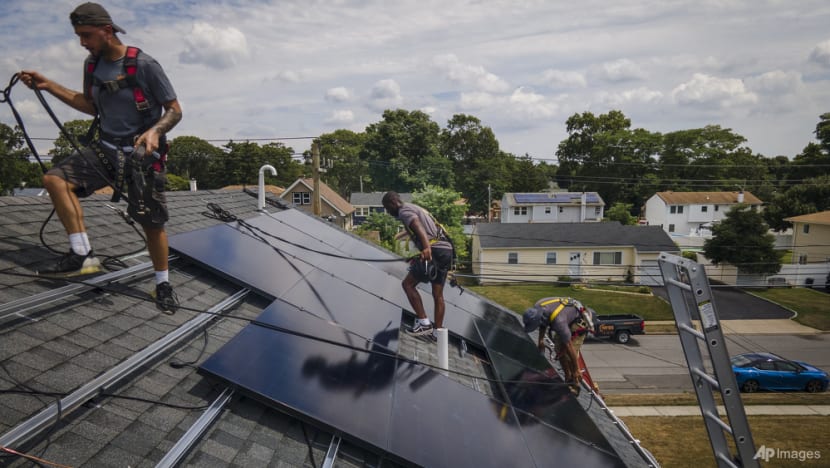‘Challenge of decarbonisation is immense’, says former US energy secretary Moniz
In the United States, for instance, there is over 2,000 gigawatts of renewable power waiting to be connected to the grid.

Decarbonizing the global economy entails rapidly phasing out coal-fired power (Photo: AFP/File/MARCO LONGARI)
There is an urgent need to close up the infrastructure gap for decarbonisation in many countries, including the United States, said observers.
This comes as the global community considers tripling global renewable energy capacity by 2030 to limit the rise in global temperatures to 1.5 degree Celsius under the Paris Agreement and avert the worst effects of climate change.
“In the United States and in other parts of the world, the infrastructure may be the pacing item,” said former US secretary of energy Ernest Moniz in an exclusive interview with CNA.
Pacing items are central to an organisation's ability to perform its mission.
RENEWABLES A CRUCIAL PART OF DECARBONISATION
In the US, for instance, there is more than 2,000 gigawatts of renewable power waiting to be connected to the grid. One gigawatt is estimated to be able to power about 750,000 homes in the US.
However, such infrastructure projects take about five to eight years, noted Dr Moniz, CEO of Energy Futures Initiative, a Washington-based nonprofit organisation dedicated to accelerating clean energy transition.
If we don't move that up to two or three years, we will not make it,” he said.
To reach the aim of containing the rise in global temperatures to 1.5 degree Celsius, emissions need to reach net zero by 2050.
“The challenge of decarbonisation is immense for everyone,” he said, adding that renewable energy will be a key part of the decarbonising solution.
“That's only 25 years away roughly, which in the energy industry would require an unprecedented pace.”
SPEEDING UP CLIMATE ACTION
Dr Moniz was speaking on the sidelines of ADIPEC 2023 in Abu Dhabi, billed as the world's largest energy exhibition and conference.
He said the capture of carbon dioxide emissions from industrial processes, and out of the air and oceans is central to a robust climate response.
“These are all areas where the oil and gas companies really have the skill sets and the workers to be able to manage,” said Dr Moniz.
“They also have a leg up on important areas like carbon capture and those kinds of technologies.”
He believes the recent extreme weather events, including scorching temperatures in some parts of the world, could push the US to speed up their climate change action.

“The politics right now is rather poisonous, and unfortunately it has spilled over into the climate discussion,” he added.
However, he said there is sufficient bipartisan support on the technology front, and that the US will make continued progress in clean energy technology.
“Where the problem comes is in policy, in regulation. That's going way too slowly,” he added.
“The extreme weather is a reality, and it is, in fact, going to be the political tipping point, I believe, sometime later in this decade for the United States to move across the board on decarbonisation.”
IS CHINA AHEAD OF ITS NET ZERO TARGETS?
More than 160,000 energy professionals are attending the four-day ADIPEC 2023 event ending on Thursday to tackle pressing energy issues, advance decarbonisation and futureproof energy systems.
Mr Francesco La Camera, director-general of the International Renewable Energy Agency (IRENA), said the world is off track in its transition to renewables.
“The speed and the scale of this transition is not putting us in a safe pathway to achieving the Paris Agreement goal to contain the increase in temperature under 1.5 degree Celsius at the end of this century,” he told CNA’s Asia Now.
However, he has noticed that in recent dialogues and tours around the world, there is a more favourable environment to support the transition as compared to a few years ago.
Related:
China, in particular, plans to achieve carbon neutrality by 2060.
It is the world’s biggest producer and consumer of energy. China's investments in its power sector may exceed 100 trillion yuan (US$13.7 trillion) from 2020 to 2060.
The country has been accelerating renewable energy generation. It announced last year its aim to source about 33 per cent of power from renewable sources by 2025, up from 28.8 per cent in 2020.
China alone accounts for 41 per cent of the global total of renewable energy jobs, according to a recent IRENA report.
Related:
“In my opinion, they are already (going) beyond their targets. They are going faster than they say (they are),” said Mr La Camera, who has more than 30 years of experience in the fields of climate, sustainability, and international cooperation.
“Because usually, in Chinese culture, when they commit, they want to be sure to get the end result. So they say 2060, but I'm sure that they will be fast enough to be already achieving their goal well before 2060.”














